Preparation of Lignin Nanoparticles from Wood Waste for Wood Surface Treatment
Abstract
:1. Introduction
2. Materials and Methods
2.1. Lignin Extraction and Preparation of Lignin Nanoparticles (LNPs)
2.2. LNPs-Coating of Beech Wood Samples
2.3. Accelerated Weathering Testing
2.4. Analytical Methods
2.5. FTIR and UV Spectroscopy
2.6. Analytical Pyrolysis
2.7. Two-Dimensional NMR Spectroscopy
2.8. Molar Mass Distribution
2.9. SEM of LNPs and LNPs-Coated Beech Wood
3. Results and Discussion
3.1. Acidolysis Lignins—Isolation and Structural Characteristics
3.2. LNPs from Iroko and Iroko–Norway Spruce Sawdust
3.3. LNPs-Coated Wood—General Morphological Characteristics
3.4. Color Analysis before and after Artificial Weathering Tests
3.5. SEM Analysis after Artificial Weathering Tests
4. Conclusions
Author Contributions
Funding
Acknowledgments
Conflicts of Interest
References
- Henriksson, G. Lignin. In Wood Chemistry and Wood Biotechnology; Ek, M., Gellerstedt, G., Henriksson, G., Eds.; Walter de Gruyter: Berlin, Germany, 2009; Volume 1, pp. 121–146. [Google Scholar]
- Saake, B.; Lehnen, R. Lignin. In Ullmann’s Encyclopedia of Industrial Chemistry; Wiley-VCH: Weinheim, Germany, 2007. [Google Scholar]
- Civardi, C.; Schwarze, F.W.M.R.; Wick, P. Micronized copper wood preservatives: An efficiency and potential health risk assessment for copper-based nanoparticles. Environ. Pollut. 2015, 200, 126–132. [Google Scholar] [CrossRef] [PubMed]
- Preston, A.F. Wood preservation. Trends of today that will influence the industry tomorrow. For. Prod. J. 2000, 50, 12–19. [Google Scholar]
- Schultz, T.P.; Nicholas, D.D. Improving the Performance of Organic Biocides by Using Economical and Benign Additives. In Development of Commercial Wood Preservatives; American Chemical Society: Washington, DC, USA, 2008; Volume 982, pp. 272–284. [Google Scholar]
- Katz, S.A.; Salem, H. Chemistry and toxicology of building timbers pressure-treated with chromated copper arsenate: a review. J. Appl. Toxicol. 2005, 25, 1–7. [Google Scholar] [CrossRef] [PubMed]
- Mench, M.; Bes, C. Assessment of Ecotoxicity of Topsoils from a Wood Treatment Site. Pedosphere 2009, 19, 143–155. [Google Scholar] [CrossRef]
- Tuck, C.O.; Perez, E.; Horvath, I.T.; Sheldon, R.A.; Poliakoff, M. Valorization of biomass: deriving more value from waste. Science 2012, 337, 695–699. [Google Scholar] [CrossRef] [PubMed]
- Sadeghifar, H.; Venditti, R.; Jur, J.; Gorga, R.E.; Pawlak, J.J. Cellulose-Lignin Biodegradable and Flexible UV Protection Film. ACS Sustain. Chem. Eng. 2017, 5, 625–631. [Google Scholar] [CrossRef]
- Qian, Y.; Qiu, X.; Zhu, S. Lignin: A nature-inspired sun blocker for broad-spectrum sunscreens. Green Chem. 2015, 17, 320–324. [Google Scholar] [CrossRef]
- Qian, Y.; Zhong, X.; Li, Y.; Qiu, X. Fabrication of uniform lignin colloidal spheres for developing natural broad-spectrum sunscreens with high sun protection factor. Ind. Crops Prod. 2017, 101, 54–60. [Google Scholar] [CrossRef]
- Chaochanchaikul, K.; Jayaraman, K.; Rosarpitak, V.; Sombatsompop, P.D.N. Influence of lignin content on photodegradation in wood/HDPE composites under UV weathering. BioResources 2011, 7, 0038–0055. [Google Scholar]
- Colom, X.; Carrillo, F.; Nogués, F.; Garriga, P. Structural analysis of photodegraded wood by means of FTIR spectroscopy. Polym. Degrad. and Stab. 2003, 80, 543–549. [Google Scholar] [CrossRef]
- Russo, D.; Macrì, G.; Luzzi, G.; De Rossi, A. Wood Energy Plants and Biomass Supply Chain in Southern Italy. Procedia Soc. Behav. Sci. 2016, 223, 849–856. [Google Scholar] [CrossRef] [Green Version]
- Paletto, A.; Giacovelli, G.; Matteucci, G.; Maesano, M.; Pastorella, F.; Turco, R.; Scarascia Mugnozza, G. Strategies for the promotion of the forest-wood chain in Calabria (southern Italy): the stakeholders’ point of view. Forest@ J. Silvic. For. Ecol. 2017, 14, 34–48. [Google Scholar] [CrossRef] [Green Version]
- Romagnoli, M.; Segoloni, E.; Luna, M.; Margaritelli, A.; Gatti, M.; Santamaria, U.; Vinciguerra, V. Wood colour in Lapacho (Tabebuia serratifolia): chemical composition and industrial implications. Wood Sci. Technol. 2013, 47, 701–716. [Google Scholar] [CrossRef]
- Christensen, L.P.; Lam, J.; Sigsgaard, T. A novel stilbene from the wood of Chlorophora excelsa. Phytochemistry 1988, 27, 3014–3016. [Google Scholar] [CrossRef]
- Onuorah, E.O. The wood preservative potentials of heartwood extracts of Milicia excelsa and Erythrophleum suaveolens. Bioresour. Technol. 2000, 75, 171–173. [Google Scholar] [CrossRef]
- Zikeli, F.; Vinciguerra, V.; Taddei Anna, R.; D’Annibale, A.; Romagnoli, M.; Scarascia Mugnozza, G. Isolation and characterization of lignin from beech wood and chestnut sawdust for the preparation of lignin nanoparticles (LNPs) from wood industry side-streams. Holzforschung 2018, 72, 961. [Google Scholar] [CrossRef]
- Smyth, M. Colloidal Lignin Particles for Weathering Protection in Wood Coatings. Master’s Thesis, Aalto University, Espoo, Finland, 2017. [Google Scholar]
- Gellerstedt, G.; Pranda, J.; Lindfors, E.L. Structural and Molecular Properties of Residual Birch Kraft Lignins. J. Wood Chem. Technol. 1994, 14, 467–482. [Google Scholar] [CrossRef]
- Lievonen, M.; Valle-Delgado, J.J.; Mattinen, M.-L.; Hult, E.-L.; Lintinen, K.; Kostiainen, M.A.; Paananen, A.; Szilvay, G.R.; Setälä, H.; Österberg, M. A simple process for lignin nanoparticle preparation. Green Chem. 2016, 18, 1416–1422. [Google Scholar] [CrossRef] [Green Version]
- Herrera, M.A.; Sirviö, J.A.; Mathew, A.P.; Oksman, K. Environmental friendly and sustainable gas barrier on porous materials: Nanocellulose coatings prepared using spin- and dip-coating. Mater. Des. 2016, 93, 19–25. [Google Scholar] [CrossRef]
- TAPPI T 222 om-02, Acid-insoluble lignin in wood and pulp. In 2002–2003 Tappi Test Methods; Tappi Press: Atlanta, GA, USA, 2002.
- Van Soest, P.J. Use of detergents in the analysis of fibrous feeds. II. A rapid method for the determination of fiber and lignin. J. Assoc. Off. Agric. Chem. 1963, 46, 829–835. [Google Scholar]
- Van Soest, P.J.; Wine, R.H. Use of Detergents in the Analysis of Fibrous Feeds. IV. Determination of Plant Cell-Wall Constituents. J. Assoc. Off. Agric. Chem. 1967, 50, 50–55. [Google Scholar]
- Faix, O.; Fortmann, I.; Bremer, J.; Meier, D. Thermal degradation products of wood: Gas chromatographic separation and mass spectrometric characterization of polysaccharide derived products. Holz als Roh- und Werkstoff 1991, 49, 213–219. [Google Scholar] [CrossRef]
- Faix, O.; Fortmann, I.; Bremer, J.; Meier, D. Thermal degradation products of wood: A collection of electron-impact (EI) mass spectra of polysaccharide derived products. Holz als Roh- und Werkstoff 1991, 49, 299–304. [Google Scholar] [CrossRef]
- Faix, O.; Meier, D.; Fortmann, I. Thermal degradation products of wood: Gas chromatographic separation and mass spectrometric characterization of monomeric lignin derived products. Holz als Roh- und Werkstoff 1990, 48, 281–285. [Google Scholar] [CrossRef]
- Faix, O.; Meier, D.; Fortmann, I. Thermal degradation products of wood: A collection of electron-impact (EI) mass spectra of monomeric lignin derived products. Holz als Roh- und Werkstoff 1990, 48, 351–354. [Google Scholar] [CrossRef]
- Vinciguerra, V.; Spina, S.; Luna, M.; Petrucci, G.; Romagnoli, M. Structural analysis of lignin in chestnut wood by pyrolysis-gas chromatography/mass spectrometry. J. Anal. Appl. Pyrolysis 2011, 92, 273–279. [Google Scholar] [CrossRef]
- Chen, T.-Y.; Wang, B.; Shen, X.-J.; Li, H.-Y.; Wu, Y.-Y.; Wen, J.-L.; Liu, Q.-Y.; Sun, R.-C. Assessment of structural characteristics of regenerated cellulolytic enzyme lignin based on a mild DMSO/[Emim]OAc dissolution system from triploid of Populus tomentosa Carr. RSC Adv. 2017, 7, 3376–3387. [Google Scholar] [CrossRef]
- del Río, J.C.; Rencoret, J.; Gutiérrez, A.; Kim, H.; Ralph, J. Hydroxystilbenes Are Monomers in Palm Fruit Endocarp Lignins. Plant Physiol. 2017, 174, 2072–2082. [Google Scholar] [CrossRef] [Green Version]
- Kim, H.; Ralph, J. Solution-state 2D NMR of ball-milled plant cell wall gels in DMSO-d6/pyridine-d5. Org. Biomol. Chem. 2010, 8, 576–591. [Google Scholar] [CrossRef] [Green Version]
- Lourenço, A.; Rencoret, J.; Chemetova, C.; Gominho, J.; Gutiérrez, A.; del Río, J.C.; Pereira, H. Lignin Composition and Structure Differs between Xylem, Phloem and Phellem in Quercus suber L. Front. Plant Sci. 2016, 7. [Google Scholar] [CrossRef]
- Noguchi, A.; Yoshihara, T.; Ichihara, A.; Sugihara, S.; Koshino, M.; Kojima, M.; Masaoka, Y. Ferric Phosphate-dissolving Compound, Alfafuran, from Alfalfa (Medicago sativa L.) in Response to Iron-deficiency Stress. Biosci. Biotechnol. Biochem. 1994, 58, 2312–2313. [Google Scholar] [CrossRef]
- Rencoret, J.; Kim, H.; Evaristo, A.B.; Gutiérrez, A.; Ralph, J.; del Río, J.C. Variability in Lignin Composition and Structure in Cell Walls of Different Parts of Macaúba (Acrocomia aculeata) Palm Fruit. J. Agric. Food Chem. 2018, 66, 138–153. [Google Scholar] [CrossRef] [PubMed]
- Shimizu, K.; Yasutake, S.; Kondo, R. A New Stilbene with Tyrosinase Inhibitory Activity from Chlorophora excelsa. Chem. Pharm. Bull. 2003, 51, 318–319. [Google Scholar] [CrossRef] [PubMed]
- Ralph, S.A.; Ralph, J.; Landucci, L.L. NMR Database of Lignin and Cell Wall Model Compounds. Available online: https://www.glbrc.org/databases_and_software/nmrdatabase/ (accessed on 20 November 2018).
- Romagnoli, M.; Vinciguerra, V.; Silvestri, A. Heat Treatment Effect on Lignin and Carbohydrates in Corsican Pine Earlywood and Latewood Studied by PY–GC–MS Technique. J. Wood Chem. Technol. 2018, 38, 57–70. [Google Scholar] [CrossRef]
- Donaldson, L.A. Lignification and lignin topochemistry—An ultrastructural view. Phytochemistry 2001, 57, 859–873. [Google Scholar] [CrossRef]
- Grundon, M.F.; King, F.E. Chlorophorin, a Constituent of Iroko, the Timber of Chlorophora excelsa. Nature 1949, 163, 564. [Google Scholar] [CrossRef] [PubMed]
- Ouete Judith, L.N.; Sandjo Louis, P.; Kapche Deccaux, W.F.G.; Yeboah Samuel, O.; Mapitse, R.; Abegaz Berhanu, M.; Opatz, T.; Ngadjui Bonaventure, T. Excelsoside: A New Benzylic Diglycoside from the Leaves of Milicia excelsa. Z. Naturforsch. C 2014, 69, 271. [Google Scholar] [CrossRef]
- Faix, O. Fourier Transform Infrared Spectroscopy. In Methods in Lignin Chemistry; Lin, S.Y., Dence, C.W., Eds.; Springer: Berlin/Heidelberg, Germany, 1992; pp. 233–241. [Google Scholar]
- Moghaddam, L.; Rencoret, J.; Maliger, V.R.; Rackemann, D.W.; Harrison, M.D.; Gutiérrez, A.; del Río, J.C.; Doherty, W.O.S. Structural Characteristics of Bagasse Furfural Residue and Its Lignin Component. An NMR, Py-GC/MS, and FTIR Study. ACS Sustain. Chem. Eng. 2017, 5, 4846–4855. [Google Scholar] [CrossRef] [Green Version]
- Jairam, S.; Bucklin, R.; Correll, M.; Sakthivel, T.S.; Seal, S.; Truett, J.; Tong, Z. UV resistance of polystyrene co-butyl acrylate (PSBA) encapsulated lignin–saponite nanohybrid composite film. Mater. Des. 2016, 90, 151–156. [Google Scholar] [CrossRef]
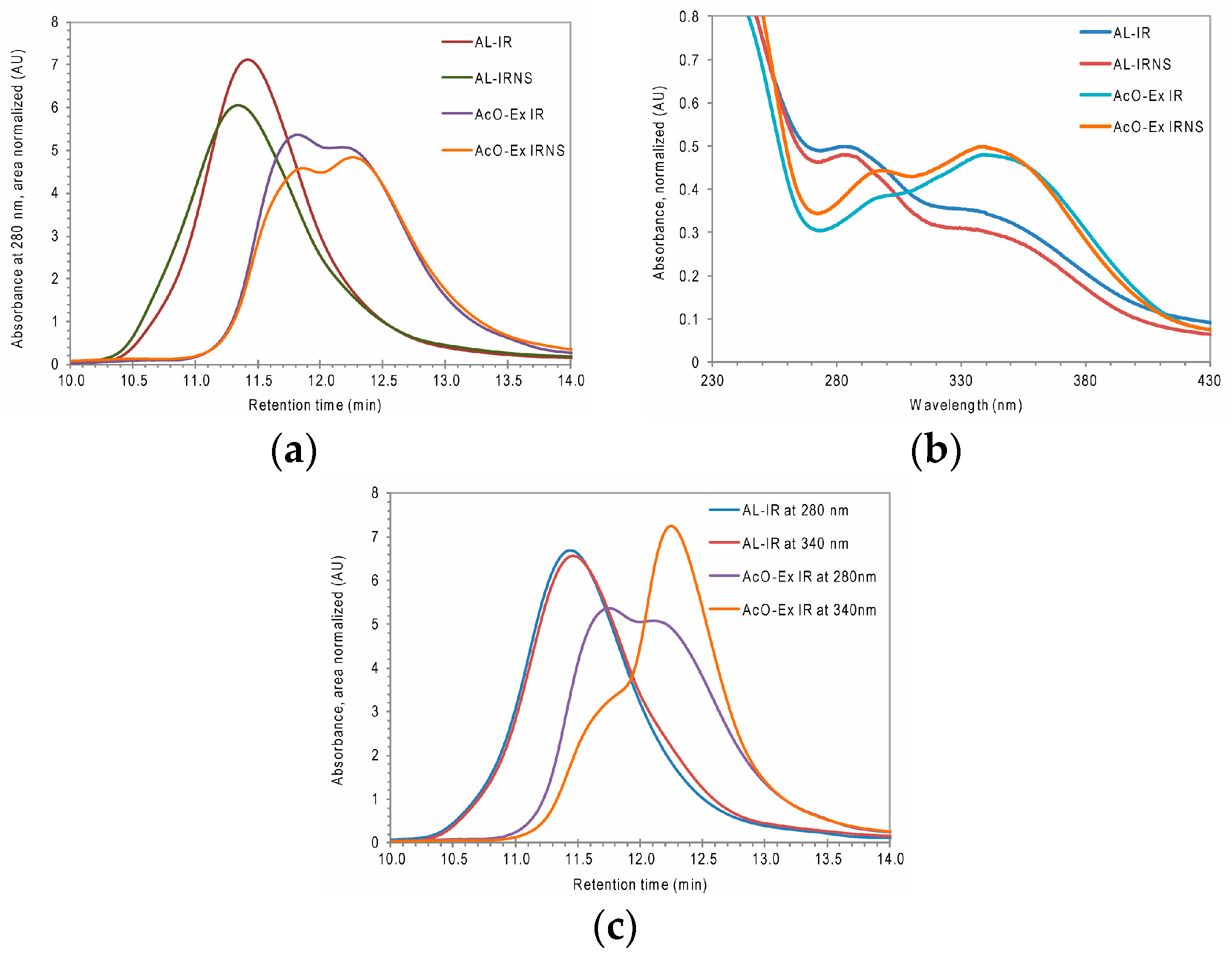
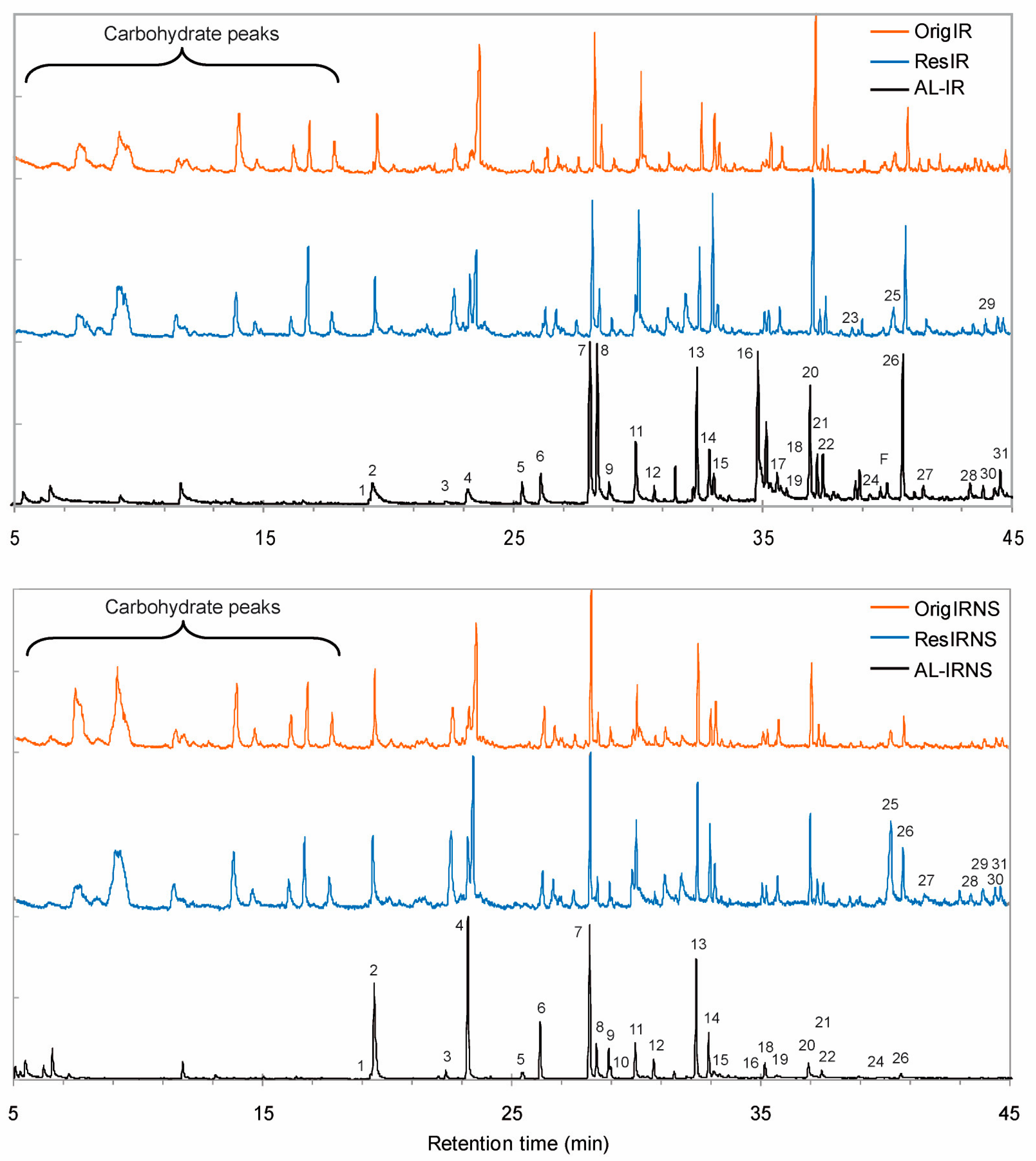
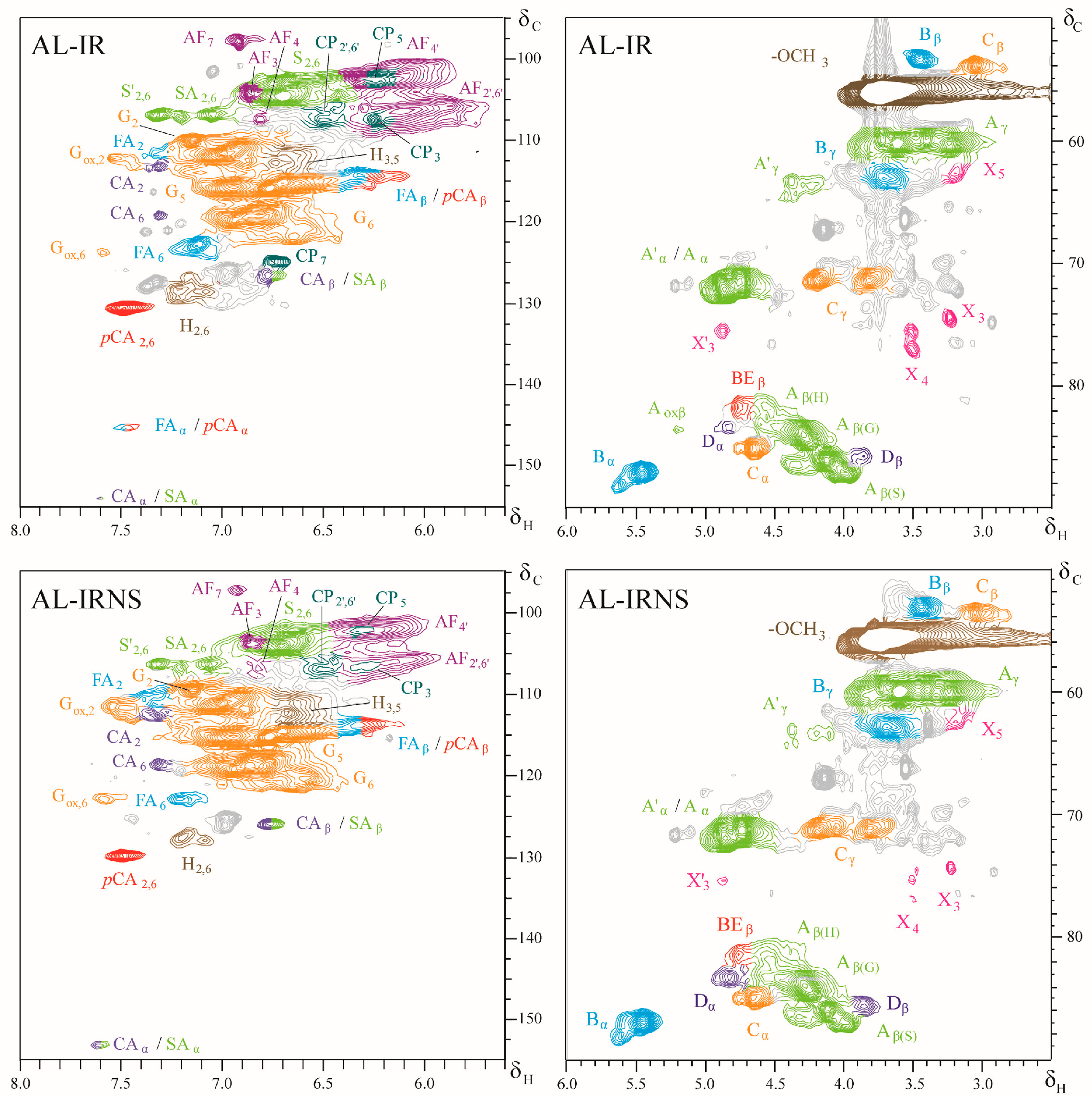
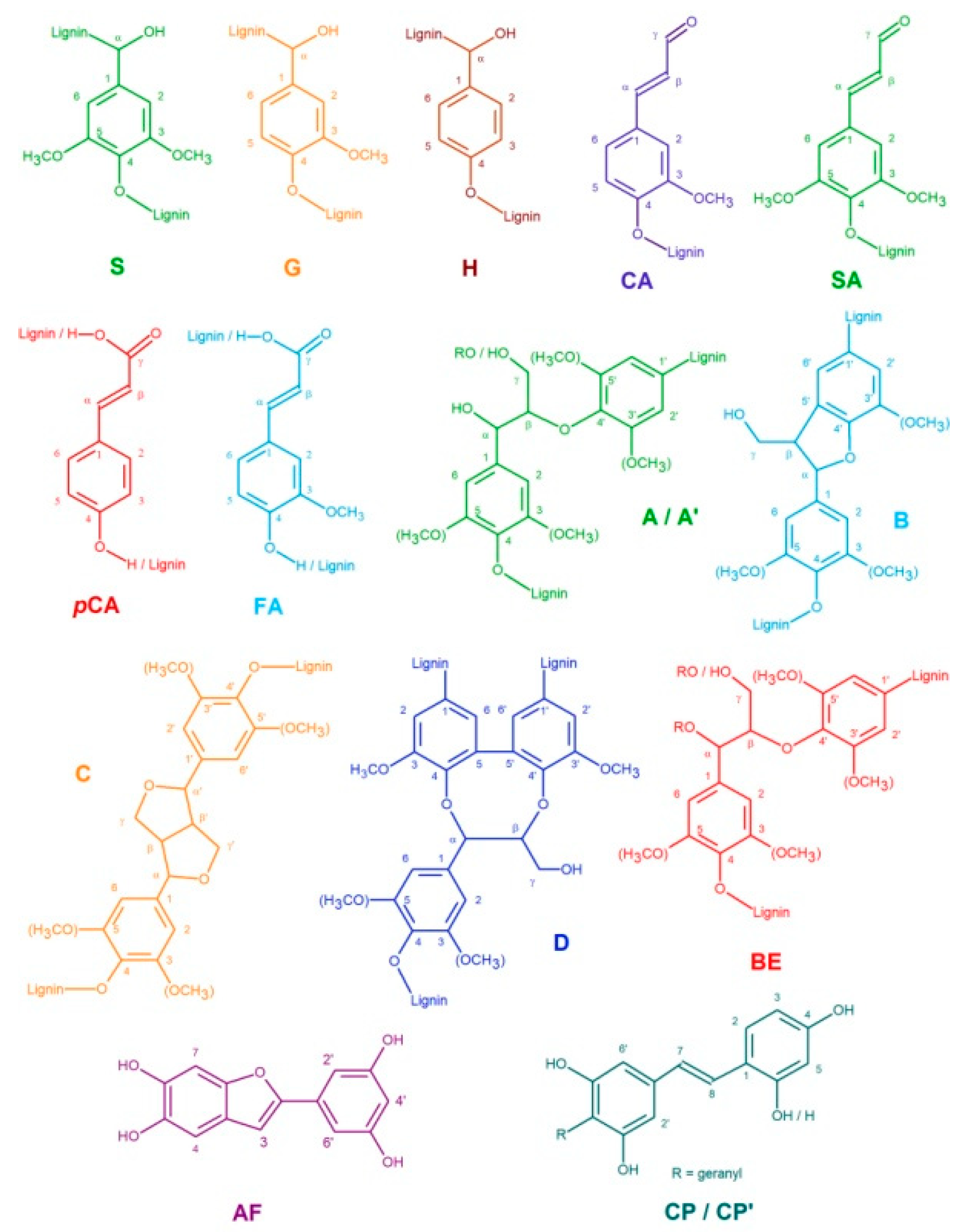



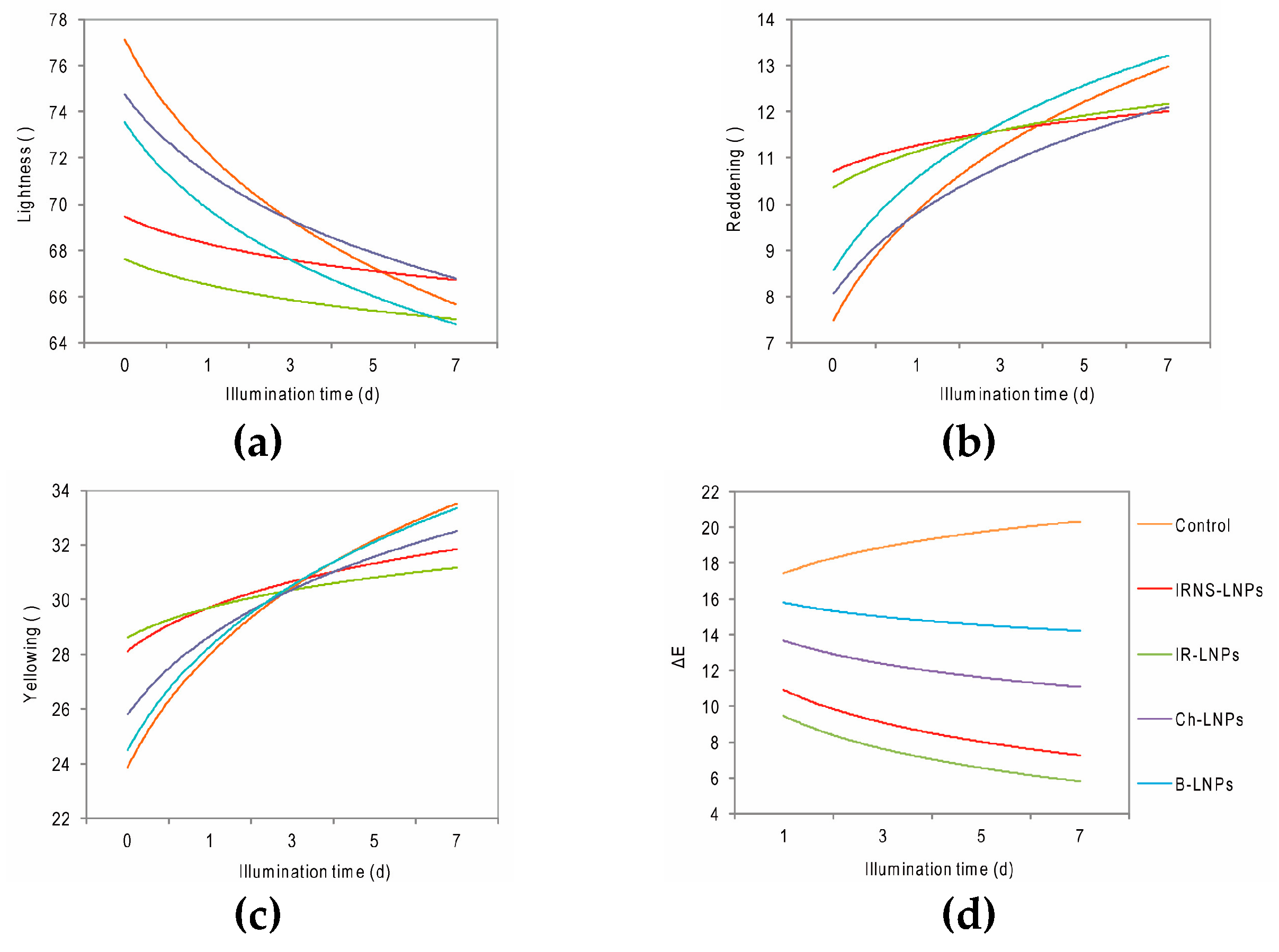
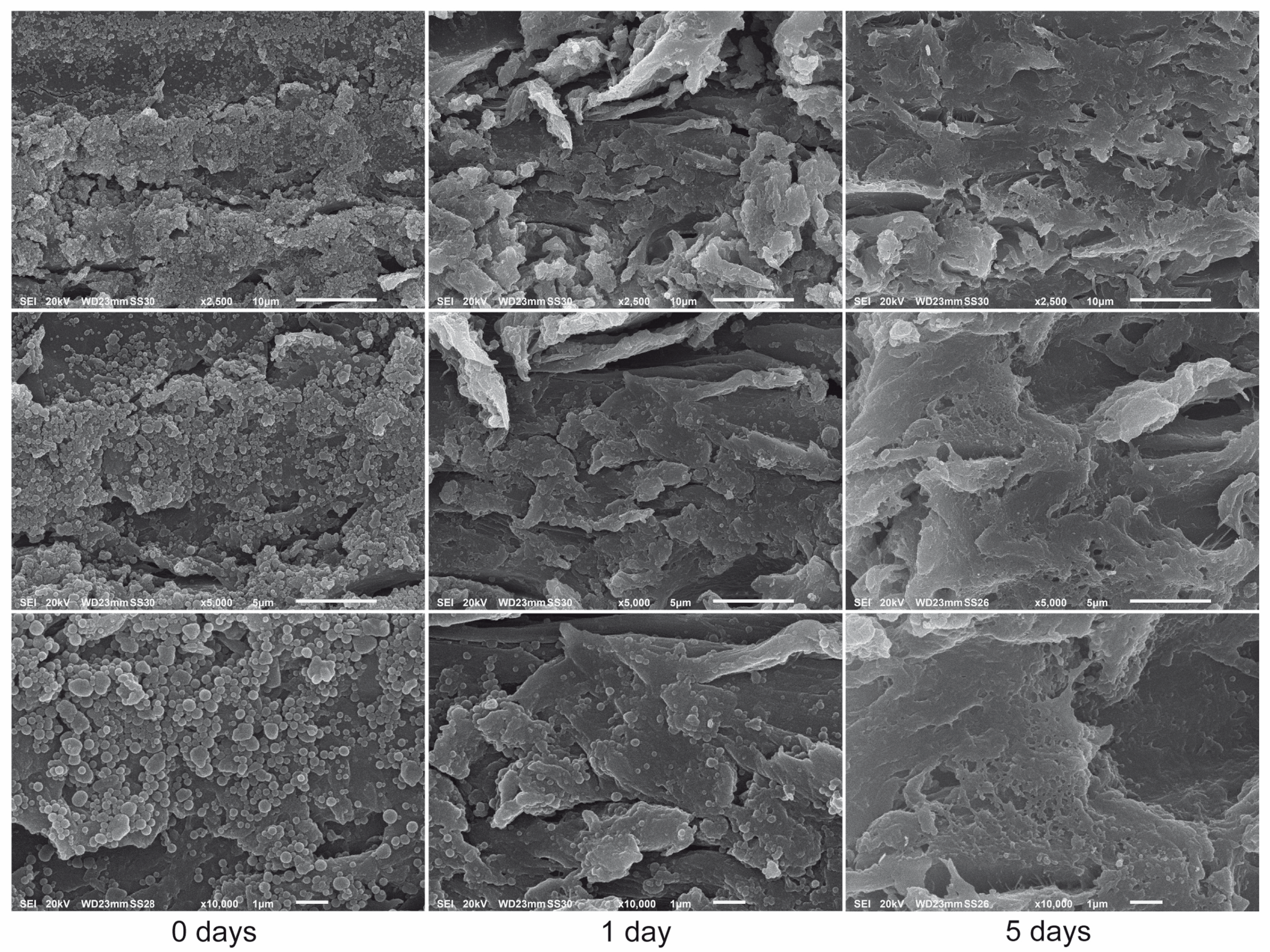
| Sample | Acetone Extractives (%) | Klason Lignin (%) | Cellulose (%) | Hemi-Celluloses (%) | Mw (kDa) | Mn (kDa) | Pd | Isolation Yield (%) |
|---|---|---|---|---|---|---|---|---|
| IR sawdust | 5.5 | 29.4 | 40.4 | 11.6 | - | - | - | - |
| ResIR | - | 25.9 | 61.5 | 1.9 | - | - | - | - |
| AL-IR | - | 87.1 | - | - | 13.9 | 2.3 | 5.7 | 19.8 |
| IRNS sawdust | 3.9 | 29.3 | 40.5 | 14.5 | - | - | - | - |
| ResIRNS | - | 25.9 | 61.6 | 2.0 | - | - | - | - |
| AL-IRNS | - | 87.7 | - | - | 17.4 | 3.1 | 5.7 | 15.2 |
| Iroko | Iroko–Norway Spruce | ||||||||
|---|---|---|---|---|---|---|---|---|---|
| Peak # | Pyrolysis Product | Origin | RT (min) | OrigIR (%) | AL-IR (%) | ResIR (%) | OrigIRNS (%) | AL-IRNS (%) | ResIRNS (%) |
| 1 | Phenol | H | 19.35 | 0.8 | 0.4 | 0.4 | 0.7 | 0.6 | 0.5 |
| 2 | Guaiacol | G | 19.51 | 7.4 | 5.0 | 5.7 | 10.2 | 16.4 | 10.0 |
| 3 | 4-Methylphenol | H | 22.35 | 0.0 | 0.3 | 0.0 | 0.0 | 1.3 | 0.0 |
| 4 | 4-Methylguaiacol | G | 23.29 | 2.3 | 2.6 | 6.0 | 20.4 | 20.0 | 7.8 |
| 5 | 4-Ethylphenol | H | 25.41 | 0.0 | 1.7 | 0.0 | 0.0 | 0.5 | 0.0 |
| 6 | 4-Ethylguaiacol | G | 26.22 | 1.4 | 3.6 | 1.0 | 1.5 | 6.1 | 0.7 |
| 7 | 4-Vinylguaiacol | G | 28.18 | 14.8 | 14.1 | 12.2 | 15.2 | 17.6 | 14.5 |
| 8 | 4-Vinylphenol | H | 28.46 | 4.4 | 11.2 | 4.9 | 3.5 | 3.5 | 2.1 |
| 9 | Eugenol | G | 28.89 | 0.9 | 0.9 | 1.0 | 1.8 | 2.8 | 2.1 |
| 10 | 4-Propylguaiacol | G | 28.95 | 0.0 | 0.0 | 0.0 | 0.7 | 3.7 | 0.0 |
| 11 | Syringol | S | 30.03 | 8.5 | 5.6 | 8.3 | 4.5 | 4.3 | 6.5 |
| 12 | Isoeugenol (cis) | G | 30.77 | 0.6 | 1.1 | 0.5 | 0.8 | 2.1 | 0.9 |
| 13 | Isoeugenol (trans) | G | 32.46 | 5.8 | 9.7 | 6.6 | 9.5 | 13.4 | 9.9 |
| 14 | 4-Methylsyringol | S | 32.99 | 6.3 | 4.4 | 11.4 | 3.3 | 4.7 | 6.8 |
| 15 | Vanillin | G | 33.18 | 3.7 | 2.5 | 3.1 | 5.6 | 1.0 | 4.6 |
| 16 | Resorcinol | Ex | 34.82 | 1.0 | 11.3 | 0.0 | 0.0 | 1.7 | 0.0 |
| 17 | Homovanillin | G | 35.42 | 1.5 | 3.7 | 2.2 | 1.4 | 0.0 | 2.3 |
| 18 | 4-Ethylsyringol | S | 35.55 | 3.9 | 7.4 | 2.0 | 1.4 | 1.8 | 1.5 |
| 19 | Acetoguaiacone | G | 35.71 | 2.9 | 3.0 | 2.8 | 2.9 | 0.6 | 3.4 |
| 20 | 4-Vinylsyringol | S | 37.00 | 16.6 | 9.7 | 12.6 | 8.6 | 2.5 | 8.0 |
| 21 | Guaiacylacetone | G | 37.31 | 2.5 | 3.3 | 2.0 | 2.2 | 0.1 | 2.3 |
| 22 | 4-Allylsyringol | S | 37.54 | 2.8 | 3.2 | 2.5 | 1.2 | 1.1 | 1.8 |
| 23 | Coniferyl alcohol (cis) | G | 38.59 | 0.6 | 0.0 | 0.0 | 0.6 | 0.0 | 1.2 |
| 24 | 4-Propenylsyringol (cis) | S | 39.35 | 1.1 | 2.1 | 1.1 | 0.5 | 0.3 | 0.8 |
| F | C11H12O3 * | 39.73 | 4.2 | 2.3 | 0.9 | 0.7 | 0.0 | 0.0 | |
| 25 | Levoglucosane | PS | 40.19 | 1.2 | 0.0 | 5.2 | 3.0 | 0.0 | 11.6 |
| 26 | 4-Propenylsyringol (trans) | S | 40.73 | 7.5 | 10.5 | 8.8 | 3.0 | 0.6 | 5.0 |
| 27 | Syringaldehyde | S | 41.44 | 1.8 | 1.6 | 2.5 | 0.5 | 0.0 | 1.3 |
| 28 | Acetosyringone | S | 43.35 | 2.0 | 1.7 | 1.1 | 0.7 | 0.0 | 1.3 |
| 29 | Coniferyl alcohol (trans) | G | 43.97 | 1.0 | 0.0 | 2.0 | 1.1 | 0.0 | 2.3 |
| 30 | Coniferaldehyde | G | 44.43 | 0.7 | 0.9 | 2.4 | 0.9 | 0.0 | 2.4 |
| 31 | Syringylacetone | S | 44.68 | 3.0 | 1.7 | 2.0 | 0.9 | 0.0 | 1.4 |
| S/G ratio | 1.16 | 0.92 | 1.11 | 0.33 | 0.18 | 0.53 | |||
| δC/δH (ppm) | Assignment (label) |
|---|---|
| 53.4/3.44 | Cβ-Hβ in phenylcoumaran β-5′ substructures (Bβ) |
| 53.9/3.05 | Cβ-Hβ in resinol substructures β-β′ (Cβ) |
| 60.0/2.96‒3.82 | Cγ-Hγ in γ-hydroxylated β-O-4′ substructures (Aγ) |
| 62.8/3.19 | C5-H5 in β-d-xylopyranoside (X5) |
| 63.2/3.69 | Cγ-Hγ in phenylcoumaran β-5′ substructures (Bγ) |
| 64.0/4.29 | Cγ-Hγ in γ-acylated β-O-4′ substructures (Aγ′) |
| 71.2/3.78 + 4.16 | Cγ-Hγ in resinol substructures β-β′ (Cγ) |
| 72.0/4.79 | Cα-Hα in β-O-4′ substructures (Aα) |
| 72.9/4.48 | C2-H2 in 2-O-acetyl-β-d-xylopyranoside (X′2) |
| 74.7/3.22 | C3-H3 in β-d-xylopyranoside (X3) |
| 75.8/4.87 | C3-H3 in 3-O-acetyl-β-d-xylopyranoside (X′3) |
| 77.2/3.50 | C4-H4 in β-d-xylopyranoside (X4) |
| 82.1/4.73 | Cα-Hα in benzyl ether substructures (BEα) |
| 82.0/4.55 | Cβ-Hβ in β-O-4′ substructures (Aβ(H)) linked to a H unit |
| 83.7/4.84 | Cα-Hα in dibenzodioxocin substructures (Dα) |
| 83.9/5.19 | Cβ-Hβ in α-oxidized (Cα=O) β-O-4′ substructures (Aoxβ) |
| 84.3/4.33 | Cβ-Hβ in β-O-4′ substructures (Aβ(G)) linked to a G unit |
| 85.2/4.62 | Cα-Hα in resinol β-β′ substructures (Cα) |
| 85.9/3.86 | Cβ-Hβ in dibenzodioxocin substructures (Dβ) |
| 86.8/4.06 | Cβ-Hβ in β-O-4′ substructures (Aβ(S)) linked to a S unit |
| 87.7/5.50 | Cα-Hα in phenylcoumaran β-5′ substructures (Bα) |
| 97.9/6.91 | C7-H7 in alfafuran (AF7) |
| 101.6/6.22 | C4′-H4′ in alfafuran (AF4′) |
| 102.8/6.32 | C5-H5 in chlorophorin (CP5) |
| 104.1/6.64 | C2,6-H2,6 in syringyl units (S2,6) |
| 104.2/6.86 | C3-H3 in alfafuran (AF3) |
| 106.9/6.16 | C2′,6′-H2′,6′ in chlorophorin (CP2′,6′) |
| 107.0/7.05 | C2,6-H2,6 in sinapaldehyde units (SA2,6) |
| 107.0/7.25 | C2,6-H2,6 in α-oxidized (Cα=O) syringyl units (S′2,6) |
| 107.1/6.46 | C2′,6′-H2′,6′ in alfafuran (AF2′,6′) |
| 107.4/6.81 | C4-H4 in alfafuran (AF4) |
| 107.5/6.46 | C3-H3 in chlorophorin (CP3) |
| 111.3/7.30 | C2-H2 in ferulic acid (FA2) |
| 111.3/7.01 | C2-H2 in guaiacyl units (G2) |
| 112.5/6.67 | C3,5-H3,5 in p-hydroxyphenyl units (H3,5) |
| 112.6/7.49 | C2-H2 in oxidized guaiacyl units (G′2) |
| 113.2/7.30 | C2-H2 in coniferaldehyde (CA2) |
| 115.9/6.96 + 6.63 | C5-H5 and C6-H6 in guaiacyl units (G5, G6) |
| 119.1/6.84 | C6-H6 in guaiacyl units (G6) |
| 119.5/6.84 | C6-H6 in coniferaldehyde (CA6) |
| 123.0/7.12 | C6-H6 in ferulic acid (FA6) |
| 125.0/6.74 | C7-H7 in chlorophorin (CP7) |
| 123.7/7.58 | C6-H6 in oxidized guaiacyl units (G′6) |
| 125.0/6.73 | Cβ-Hβ in cinnamyl aldehyde end groups (CAβ) |
| 128.9/7.14 | C2,6-H2,6 in p-hydroxyphenyl units (H2,6) |
| 129.6/7.91 | C2,6-H2,6 in p-coumaric acid (pCA2,6) |
| 145.2/7.46 | Cα-Hα in p-coumaric and ferulic acid (pCAα, FAα) |
| 154.0/7.60 | Cα-Hα in cinnamyl aldehyde end groups (CAα, SAα) |
| Lignin Fraction | Monomeric Ratio (%) | S/G Ratio | Inter-Unit Linkages (%) | CA End Groups (%) | ||||||
|---|---|---|---|---|---|---|---|---|---|---|
| S | G | H | β-O-4′ | β-5′ | β-β′ | BE | DBDO | |||
| AL-IR | 44 | 51 | 5 | 0.86 | 74 | 15 | 5 | 4 | 2 | 2 |
| AL-IRNS | 22 | 75 | 3 | 0.30 | 71 | 19 | 4 | 2 | 4 | 2 |
© 2019 by the authors. Licensee MDPI, Basel, Switzerland. This article is an open access article distributed under the terms and conditions of the Creative Commons Attribution (CC BY) license (http://creativecommons.org/licenses/by/4.0/).
Share and Cite
Zikeli, F.; Vinciguerra, V.; D’Annibale, A.; Capitani, D.; Romagnoli, M.; Scarascia Mugnozza, G. Preparation of Lignin Nanoparticles from Wood Waste for Wood Surface Treatment. Nanomaterials 2019, 9, 281. https://doi.org/10.3390/nano9020281
Zikeli F, Vinciguerra V, D’Annibale A, Capitani D, Romagnoli M, Scarascia Mugnozza G. Preparation of Lignin Nanoparticles from Wood Waste for Wood Surface Treatment. Nanomaterials. 2019; 9(2):281. https://doi.org/10.3390/nano9020281
Chicago/Turabian StyleZikeli, Florian, Vittorio Vinciguerra, Alessandro D’Annibale, Donatella Capitani, Manuela Romagnoli, and Giuseppe Scarascia Mugnozza. 2019. "Preparation of Lignin Nanoparticles from Wood Waste for Wood Surface Treatment" Nanomaterials 9, no. 2: 281. https://doi.org/10.3390/nano9020281







